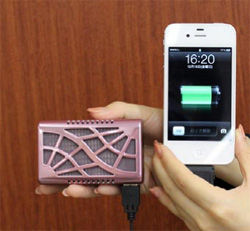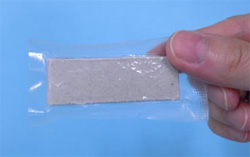Home > Highlighting JAPAN > Highlighting Japan FEBRUARY 2013 > Safe and Efficient Hydrogen Fuel Cells
Highlighting JAPAN
[SERIES] SCIENCE & TECHNOLOGY
Safe and Efficient Hydrogen Fuel Cells
Fuel cells have gained a lot of attention as a next-generation power source, and their performance is expected to improve even further. Amid the development competition underway in various countries, a fuel cell charger using a solid hydrogen source for smartphones developed by Kyoto-based Rohm Co. and partners has achieved a groundbreaking compact size. Takashi Sasaki reports.

USB-compatible solid fuel type hydrogen fuel cell for recharging smartphones (left)
Credit: COURTESY OF ROHM CO., LTD.
So says Akira Kamisawa, director of the Research and Development Headquarters at Rohm Co., a semiconductor manufacturer in Kyoto. When water is electrolyzed, it generates hydrogen and oxygen. Simply put, hydrogen fuel cells are a way to draw electricity from hydrogen in a completely reversed chemical reaction process.
The solid hydrogen source fuel cell was announced in September 2012 out of the joint development efforts of Rohm Co., Kyoto University, and Aquafairy Corporation, another fuel cell venture headquartered in Kyoto. This USB-compatible smartphone recharger is only 86 mm long, 52 mm wide, and 19 mm thick, and fits comfortably in your palm. It weighs only 73 g, including the built-in hydrogen generator cartridge. It's so compact you'll hardly notice it if you carry it in your pocket or bag.
Since most conventionally developed hydrogen fuel cells store hydrogen in a cylinder, their drawbacks were that they were big, heavy, and hard to handle. In contrast, instead of hydrogen cylinders, the solid hydrogen source fuel cell uses sheet-type solid calcium hydride placed in an attached cartridge that was developed using proprietary technologies. If you compare fuel cells for smartphones, this groundbreaking compact fuel cell is only about a third of the size and weight of conventional models.
Kamisawa explains the development work thus:

A small sample piece of calcium hydride solidified in sheet form
Credit: COURTESY OF ROHM CO., LTD.
The solid hydride source sheet placed in the attached cartridge is 38 mm long, 38 mm wide, and only 2 mm thick. By adding water (several cc), it generates about 4.5 liters of hydrogen, enabling 5 Whr of electricity to be supplied, which is enough to fully recharge a smartphone. Only a minute amount of heat is generated during operation, and the amount of water vapor created when the hydrogen and oxygen in the air are bonded is only about as much as that in a baby's exhaled air. Hydrogen is often associated with dangerous situations, but anyone can use this product safely. Unlike dry cells, whose performance gradually declines due to the voltage difference inside, the laminated aluminum-wrapped calcium hydride is capable of maintaining its initial energy for twenty years. Furthermore, it is believed that volume production will keep the price at a level similar to the lithium-ion batteries used for digital cameras and other equipment.
By varying the size of the attached cartridge and the reaction time, Rohm Co. and partners have developed various other types of hydrogen fuel cells in addition to this extremely-compact type for smartphones. These include a large-output type with a rated output of 200 W for use as an outdoor power source and during times of disasters, and a large-capacity type capable of generating 400 Whr of power and supplying electricity to seismometers and other equipment over the long term. Including those three kinds of fuel cells, they are conducting a market survey in order to generate their business model in the spring. While the fuel cell for smartphones is a disposable type where the cartridge must be replaced each time, the large-output types can be turned on and off just like a gasoline-fueled power generator. These convenient features have caused various institutes and business organizations around the world to focus on these new hydrogen fuel cells made in Kyoto as a clean power source that doesn't emit noise or harmful substances.
© 2009 Cabinet Office, Government of Japan






